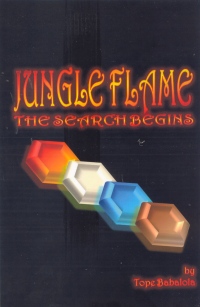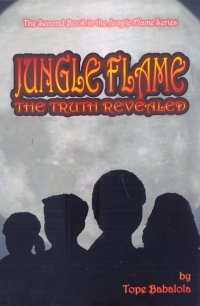| ________________
CM . . .
. Volume XXI Number 9 . . . . October 31, 2014
excerpt:
According to an article in one of Winnipeg’s local community newspapers, Tope Babalola was just 14-years-old when the first volume of this planned trilogy was published in 2012. The same article also said that Tope had been inspired to write a survival type of book after completing a school assignment that involved his reading Gary Paulsen’s Hatchet. How does one review books written and self-published by a teen? On the one hand, writing two novels that together total some 400 pages is a significant achievement and something that very few adolescents can claim to have done. However, Tope is not giving his books away for free, and they are in the commercial marketplace where they are competing for the limited dollars that school and public libraries (as well as parents) have to spend on books. Consequently, because CM is a selection tool, this periodical’s reviewers must not just offer a description of a book’s contents, but they must also provide evaluative comments to assist those who have been tasked with making personal or institutional purchases of Canadian books for juveniles. If Tope’s books were the result of a school assignment, and I was his teacher, I would give him an A+ as a final grade. The fact that he has completed two full-length novels and has a third on the way speaks to his commitment to creative writing. He has an incredible vocabulary, and he demonstrates that he can plot. He displays consistency in the characterization of his major players while also showing their growth as the story progresses. And Tope’s imagination seems to be almost without limits as he creates the various dangerous creatures that the juvenile quartet must vanquish in order to achieve their “quest”. As I began to read the first volume, The Search Begins, I thought Tope was writing a Robinsonade, a desert island survival tale. However, as I read on, I found myself also thinking of Alice's Adventures in Wonderland as the adolescents encountered giant insects and other strange, deadly creatures. The books’ initial central characters are siblings Joshua “Josh” McAllister, 14, and his sisters, Juliette “Julie”, 10, and Stephanie “Anna”, 13. Their parents have become very rich after inventing a spray “that could immediately heal any wound or broken bone in the human body.” While the family is flying on their private plane from their Florida home to a vacation in the Bahamas, the plane begins to malfunction, and the adult McAllisters give their children the aircraft’s only parachutes and have them bail out. Shortly thereafter, as the threesome parachute earthward, they see the plane explode. Despite bailing out over water, all three manage to land safely on an island, one which they later discover does not seem to be on any charts. Josh, who assumes the leadership role, immediately suspects that his nasty paternal uncle, Frederick, who had been sponging off the family, was behind what happened to the plane, and that Frederick’s motive was greed with his reward being the inheritance that would be his if the entire family perished. Now, in a typical Robinsonade, those marooned on the island would have first dealt with their immediate survival needs - water, food and shelter, plus figuring out how to protect themselves from anything on the island that might wish to harm them. And, of course, they would also want to try to identify a means of escaping the island on their own or via alerting possible rescuers. The group gets quickly sidetracked when they find an envelope containing a map and a journal produced by Alexander Murchison, a cartographer, who had been in search of the Sacred Kingdom, a source of “huge amounts of treasure”. However, before anyone can go to the Sacred Kingdom, four element jewels - water, air, earth and fire - must be secured, and each of the jewels is secreted in a different location on the island and guarded by something deadly. Calling their quest “Operation Jungle Flame”, Josh leads his sisters, and later Colton Forester, 13, another recent plane crash survivor the siblings stumble upon, in search of the four jewels, three of which are in their possession by the end of the second book, The Truth Revealed. Are these two books worthy of purchase by a school or public library? The short answer is no. While fiction, especially that containing elements of fantasy, always demands a certain amount of willing suspension of disbelief, these two volumes simply demand too much from readers in that regard. Chance (or luck) also plays an overly significant role in the plot. For example, when times get tough, lo and behold, the group just happens to find another note left by Alexander Murchison, the content of which helps them to deal with what is confronting them. And one of the biggest problems with the two volumes is that they are overwritten. Whether the happening is insignificant or of major importance, the writing is burdened by a surfeit of words. While I praised Tope for his vast vocabulary, he needed to rein it in significantly. Let’s use the excerpt above as an example. In terms of the plot, the important point is that the plane is in distress. The pilots are bit players whose role in the books will disappear when the plane explodes. Do readers really need to know their names, what they are wearing, or their hair colour and style? This “over-description” occurs repeatedly throughout the books. An editor’s hand, in addition to correcting numerous sentence faults and punctuation errors, would have significantly reduced the two books’ lengths while significantly pumping up their pace. A publisher’s fact checker would have also had something to say about the cockpit’s missing CB radio (along with other errors of fact). Because Jungle Flame: The Search Begins is essentially told from the quartet’s perspective, it is jarring to have sections of Jungle Flame: The Truth Revealed suddenly occurring largely in the present in the McAllister’s Florida home and featuring villainous Uncle Frederick and the family’s chef, Jaime Winters. When Frederick unexpectedly fires Jaime, she conveniently suspects that he is hiding something connected with the family members’ deaths, and she decides to become an amateur sleuth. This plot element awaits development in the trilogy’s final volume as does the search for the final jewel and the means by which the foursome will escape the island, a challenge given that, apparently, the island can only be seen by those in need of rescue. As impressive as these two books are, given the author’s age, their quality does not rise to a level sufficient to merit institutional purchase. Not Recommended. Dave Jenkinson, CM’s editor, lives in Winnipeg, MB.
To comment on this title or this review, send mail to cm@umanitoba.ca.
Copyright © the Manitoba Library Association. Reproduction for personal use is permitted only if this copyright notice is maintained. Any
other reproduction is prohibited without permission.
CM Home | Next Review | Table of Contents for This Issue - October 31, 2014 | Back Issues | Search | CM Archive | Profiles Archive |

